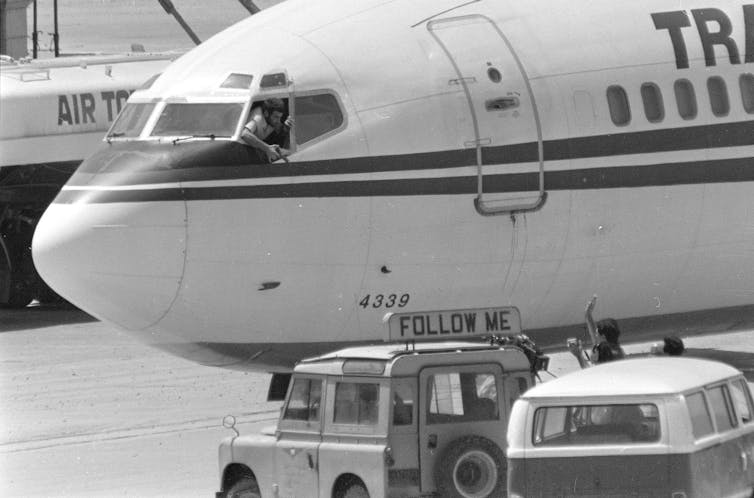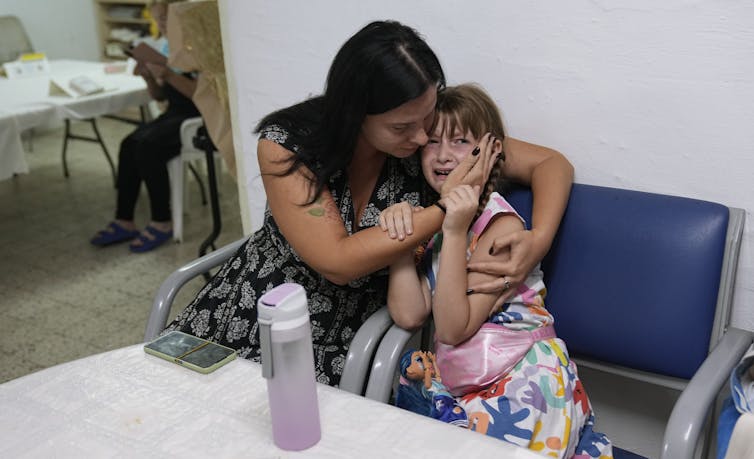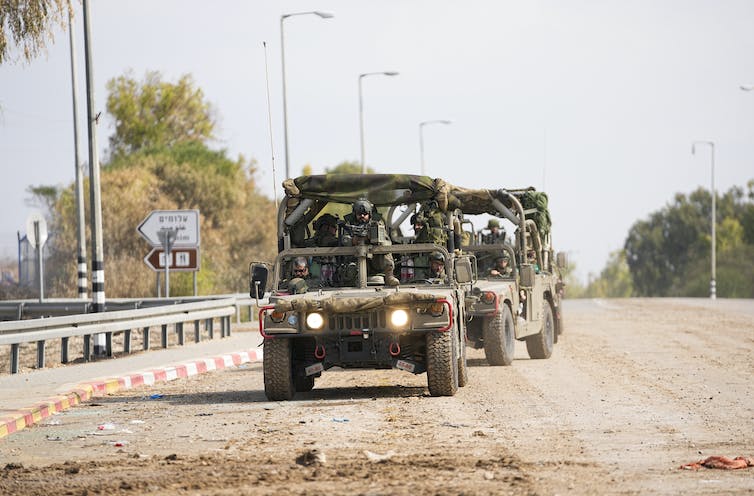It is usually quite difficult to get people and things in and out of Gaza. Until this weekend.
Thousands of rockets poured out of Gaza, and more than 100 Israelis were taken hostage by Hamas.
Gilad Erdan, Israel’s ambassador to the United Nations, has said the total number of hostages seized was between 100 and 150. The Times of Israel has reported that most of the hostages have been identified and that families were being notified.
Videos of Israelis being abducted were filmed by Hamas and shared on social media and through WhatsApp groups.
But where these hostages are being held is anyone’s guess.
Qatari officials have been attempting to broker a prisoner exchange of 36 Palestinian women and children held by Israel in exchange for the hostages taken by Hamas.
Hamas, meantime, has announced that it’s not prepared to discuss a “prisoner exchange” until the end of the conflict.
A couple of different messages can be taken from this.
(AP Photo/Ohad Zwigenberg)
Deterring retaliation?
First, it could mean that Israeli hostages are being held across Gaza in order to deter any major bombardment from Israel or to deter Israeli defence forces from a ground invasion.
Or it could mean that Hamas itself is unclear as to how many hostages it has, and who they are.
Already video footage has surfaced of Israeli hostages executed in Gaza by Hamas militants carrying assault rifles. Another video showed a German woman dragged through the streets in Gaza.
Israelis have been taken as hostages before. In 1985, a Trans World Airlines jet with 139 passengers and a crew of eight was hijacked by two Lebanese terrorists who demanded the release of 700 Shi’ite Muslims from Israeli custody.
In 2011, 1,027 Palestinians were exchanged for one Israeli soldier, Gilad Shalit, captured by Hamas in 2006.
In 2014, Hamas kidnapped and executed three Israeli teenagers.
But this time it is different.

(AP Photo/Herve Merliac)
Highly orchestrated
This is no ordinary prisoner diplomacy. This is not a desperate attempt to free prisoners on the other side or to broker a deal. Nor is it using civilian prisoners in a diplomatic proxy war, like the exchange between Canada and China for Chinese telecommunications executive Meng Wanzhou for the “Two Michaels.”
Meng for the two Michaels: Lessons for the world from the China-Canada prisoner swap
It’s a highly orchestrated act by Hamas meant to achieve three political goals.
The first is to disrupt the emerging diplomacy between Israel and Saudi Arabia. The second is to mock Benjamin Netanyahu’s war hawk platform. And finally, it could be aimed at undermining Fatah’s stated role as representing the Palestinian people.
While Hamas advocates using armed resistance and has called for the destruction of Israel, Fatah believes in negotiating with Israel for a two-state solution and has ruled out using force.
Israel-Palestine conflict: the role of Hamas and Fatah rivalry in latest violence
A living nightmare
The Israeli hostages in Gaza are living a nightmare. They’re likely to remain displaced, under duress and will be the human shields of this war.
The confidence of Hamas to carry out this attack is also cause for concern. Who is providing resources and arms to Hamas needs to be made clear. Already Israel has intercepted chemicals destined to be rocket fuel, and has gathered intelligence revealing that Hamas acquires weapons through complex smuggling networks involving sea-to-sea transfers.

(AP Photo/Ohad Zwigenberg)
After the initial bombardment, it appears Hamas is preparing for an Israeli ground invasion, counting on Israel’s internal political chaos and assuming the Israeli target list for aerial assault is now outdated.
If ground fighting breaks out between Hamas and Israeli forces, the hostages will likely be squarely in the middle of it.
For this war, these hostages are not meant to be used to solve diplomatic spats. They are intended to be put in the deadly cross-hairs of what is certainly going to continue to be a brutal and bloody conflict.




